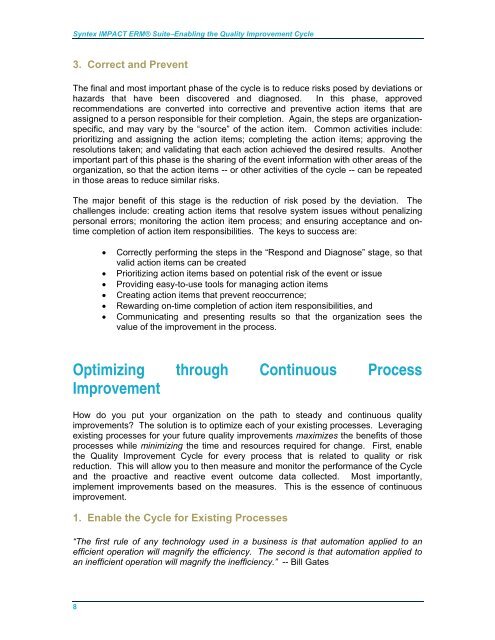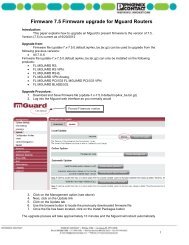Improving Quality While Managing Risk-Related ... - ISSSource
Improving Quality While Managing Risk-Related ... - ISSSource
Improving Quality While Managing Risk-Related ... - ISSSource
Create successful ePaper yourself
Turn your PDF publications into a flip-book with our unique Google optimized e-Paper software.
Syntex IMPACT ERM® SuiteEnabling the <strong>Quality</strong> Improvement Cycle<br />
3. Correct and Prevent<br />
The final and most important phase of the cycle is to reduce risks posed by deviations or<br />
hazards that have been discovered and diagnosed. In this phase, approved<br />
recommendations are converted into corrective and preventive action items that are<br />
assigned to a person responsible for their completion. Again, the steps are organizationspecific,<br />
and may vary by the “source” of the action item. Common activities include:<br />
prioritizing and assigning the action items; completing the action items; approving the<br />
resolutions taken; and validating that each action achieved the desired results. Another<br />
important part of this phase is the sharing of the event information with other areas of the<br />
organization, so that the action items -- or other activities of the cycle -- can be repeated<br />
in those areas to reduce similar risks.<br />
The major benefit of this stage is the reduction of risk posed by the deviation. The<br />
challenges include: creating action items that resolve system issues without penalizing<br />
personal errors; monitoring the action item process; and ensuring acceptance and ontime<br />
completion of action item responsibilities. The keys to success are:<br />
Correctly performing the steps in the “Respond and Diagnose” stage, so that<br />
valid action items can be created<br />
Prioritizing action items based on potential risk of the event or issue<br />
Providing easy-to-use tools for managing action items<br />
Creating action items that prevent reoccurrence;<br />
Rewarding on-time completion of action item responsibilities, and<br />
Communicating and presenting results so that the organization sees the<br />
value of the improvement in the process.<br />
Optimizing through Continuous Process<br />
Improvement<br />
How do you put your organization on the path to steady and continuous quality<br />
improvements? The solution is to optimize each of your existing processes. Leveraging<br />
existing processes for your future quality improvements maximizes the benefits of those<br />
processes while minimizing the time and resources required for change. First, enable<br />
the <strong>Quality</strong> Improvement Cycle for every process that is related to quality or risk<br />
reduction. This will allow you to then measure and monitor the performance of the Cycle<br />
and the proactive and reactive event outcome data collected. Most importantly,<br />
implement improvements based on the measures. This is the essence of continuous<br />
improvement.<br />
1. Enable the Cycle for Existing Processes<br />
“The first rule of any technology used in a business is that automation applied to an<br />
efficient operation will magnify the efficiency. The second is that automation applied to<br />
an inefficient operation will magnify the inefficiency.” -- Bill Gates<br />
8




